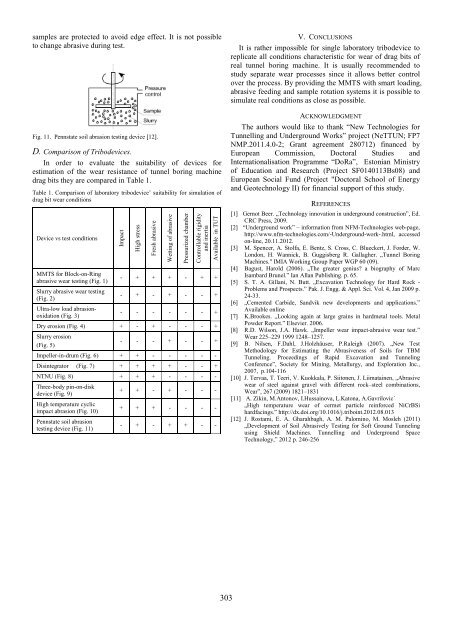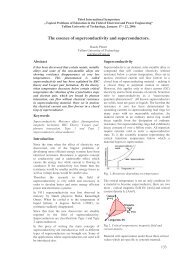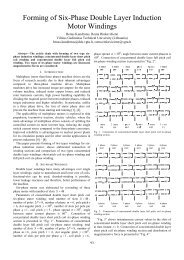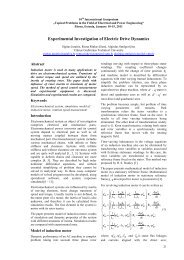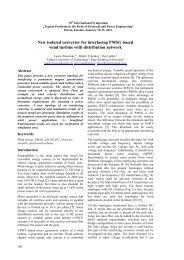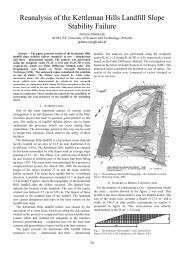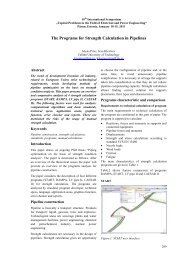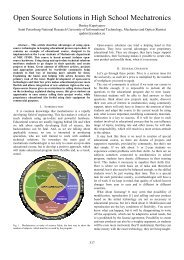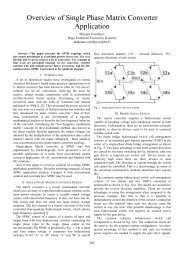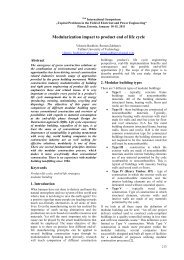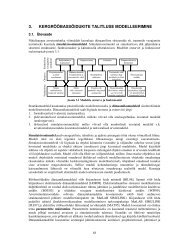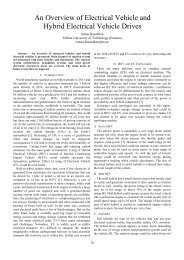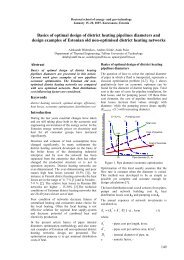Laboratory Testing of Materials for Tunnel Boring Machine Drag Bits
Laboratory Testing of Materials for Tunnel Boring Machine Drag Bits
Laboratory Testing of Materials for Tunnel Boring Machine Drag Bits
- No tags were found...
You also want an ePaper? Increase the reach of your titles
YUMPU automatically turns print PDFs into web optimized ePapers that Google loves.
samples are protected to avoid edge effect. It is not possibleto change abrasive during test.Fig. 11. Pennstate soil abrasion testing device [12].D. Comparison <strong>of</strong> Tribodevices.In order to evaluate the suitability <strong>of</strong> devices <strong>for</strong>estimation <strong>of</strong> the wear resistance <strong>of</strong> tunnel boring machinedrag bits they are compared in Table 1.Table 1. Comparison <strong>of</strong> laboratory tribodevice’ suitability <strong>for</strong> simulation <strong>of</strong>drag bit wear conditionsDevice vs test conditionsMMTS <strong>for</strong> Block-on-Ringabrasive wear testing (Fig. 1)Slurry abrasive wear testing(Fig. 2)Ultra-low load abrasionoxidation(Fig. 3)ImpactHigh stressFresh abrasiveWetting <strong>of</strong> abrasivePressurized chamberControllable rigidityand inertiaAvailable in TUT- + + + - + +- + - + - - +- - - - - - +Dry erosion (Fig. 4) + - + - - - +Slurry erosion(Fig. 5)- - - + - - +Impeller-in-drum (Fig. 6) + + - - - - -Disintegrator (Fig. 7) + + + + - - +NTNU (Fig. 8) + + + - - - -Three-body pin-on-diskdevice (Fig. 9)High temperature cyclicimpact abrasion (Fig. 10)Pennstate soil abrasiontesting device (Fig. 11)+ + - + - - -+ + + - - - -- + - + + - -V. CONCLUSIONSIt is rather impossible <strong>for</strong> single laboratory tribodevice toreplicate all conditions characteristic <strong>for</strong> wear <strong>of</strong> drag bits <strong>of</strong>real tunnel boring machine. It is usually recommended tostudy separate wear processes since it allows better controlover the process. By providing the MMTS with smart loading,abrasive feeding and sample rotation systems it is possible tosimulate real conditions as close as possible.ACKNOWLEDGMENTThe authors would like to thank “New Technologies <strong>for</strong><strong>Tunnel</strong>ling and Underground Works” project (NeTTUN; FP7NMP.2011.4.0-2; Grant agreement 280712) financed byEuropean Commission, Doctoral Studies andInternationalisation Programme “DoRa”, Estonian Ministry<strong>of</strong> Education and Research (Project SF0140113Bs08) andEuropean Social Fund (Project "Doctoral School <strong>of</strong> Energyand Geotechnology II) <strong>for</strong> financial support <strong>of</strong> this study.REFERENCES[1] Gernot Beer. „Technology innovation in underground construction”, Ed.CRC Press, 2009.[2] “Underground work” – in<strong>for</strong>mation from NFM-Technologies web-page,http://www.nfm-technologies.com/-Underground-work-.html, accessedon-line, 20.11.2012.[3] M. Spencer, A. Stolfa, E. Bentz, S. Cross, C. Blueckert, J. Forder, W.London, H. Wannick, B. Guggisberg R. Gallagher. „<strong>Tunnel</strong> <strong>Boring</strong><strong>Machine</strong>s." IMIA Working Group Paper WGP 60 (09).[4] Bagust, Harold (2006). „The greater genius? a biography <strong>of</strong> MarcIsambard Brunel.” Ian Allan Publishing. p. 65.[5] S. T. A. Gillani, N. Butt. „Excavation Technology <strong>for</strong> Hard Rock -Problems and Prospects.” Pak. J. Engg. & Appl. Sci. Vol. 4, Jan 2009 p.24-33.[6] „Cemented Carbide, Sandvik new developments and applications.”Available online[7] K.Brookes. „Looking again at large grains in hardmetal tools. MetalPowder Report.” Elsevier. 2006.[8] R.D. Wilson, J.A. Hawk. „Impeller wear impact-abrasive wear test.”Wear 225–229 1999 1248–1257.[9] B. Nilsen, F.Dahl, J.Holzhäuser, P.Raleigh (2007). „New TestMethodology <strong>for</strong> Estimating the Abrasiveness <strong>of</strong> Soils <strong>for</strong> TBM<strong>Tunnel</strong>ing. Proceedings <strong>of</strong> Rapid Excavation and <strong>Tunnel</strong>ingConference”, Society <strong>for</strong> Mining, Metallurgy, and Exploration Inc.,2007, p.104-116[10] J. Tervaa, T. Teeri, V. Kuokkala, P. Siitonen, J. Liimatainen, „Abrasivewear <strong>of</strong> steel against gravel with different rock–steel combinations,Wear”, 267 (2009) 1821–1831[11] A. Zikin, M.Antonov, I.Hussainova, L.Katona, A.Gavrilovic´„High temperature wear <strong>of</strong> cermet particle rein<strong>for</strong>ced NiCrBSihardfacings.” http://dx.doi.org/10.1016/j.triboint.2012.08.013[12] J. Rostami, E. A. Gharahbagh, A. M. Palomino, M. Mosleh (2011)„Development <strong>of</strong> Soil Abrasively <strong>Testing</strong> <strong>for</strong> S<strong>of</strong>t Ground <strong>Tunnel</strong>ingusing Shield <strong>Machine</strong>s. <strong>Tunnel</strong>ling and Underground SpaceTechnology,” 2012 p. 246-256303


